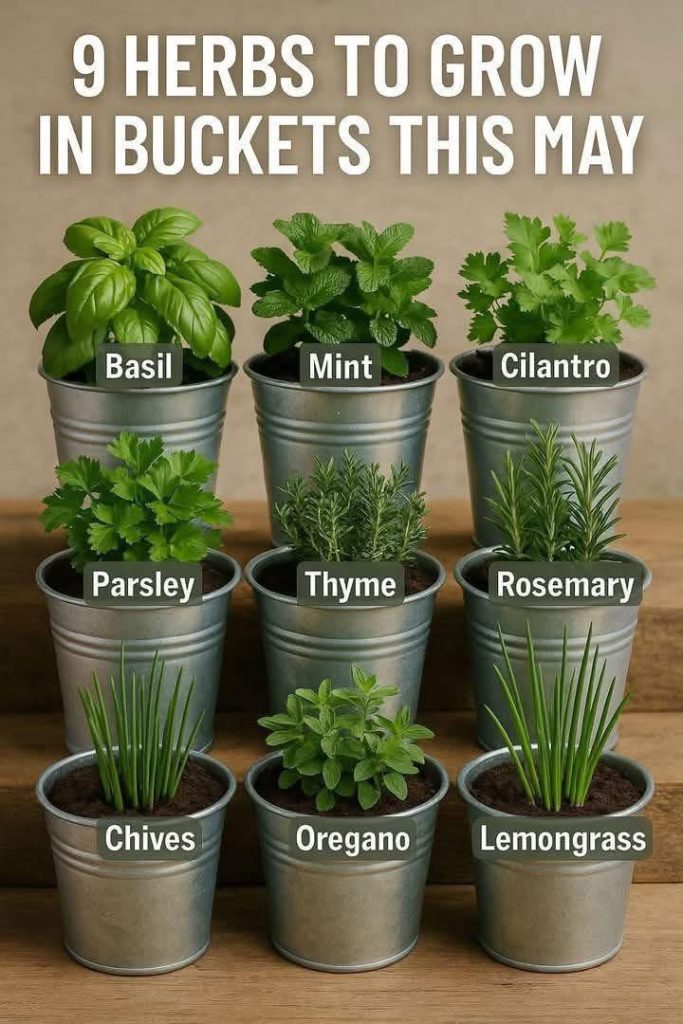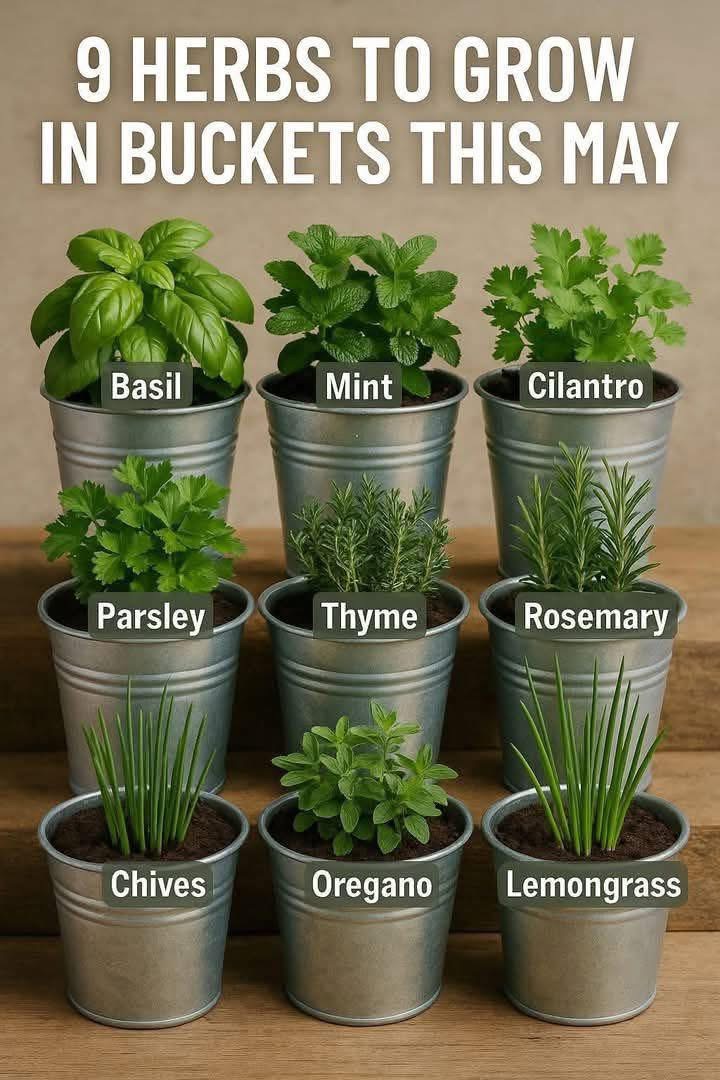
9 Herbs to Grow in Buckets This May – A Complete Guide
Spring is the perfect time to start your own herb garden, and May offers ideal conditions for planting many culinary herbs. Whether you’re short on space or just want a convenient kitchen garden, growing herbs in buckets or containers is a practical and rewarding option.
Below are nine powerhouse herbs you can grow in small spaces, even on a balcony or windowsill.
1. Basil (Ocimum basilicum)
Why Grow Basil
- Classic in Mediterranean cuisine
- Rich in antioxidants and anti-inflammatory compounds
- Excellent companion plant (repels mosquitoes, attracts pollinators)
Growing Conditions
- Sunlight: 6–8 hours full sun daily
- Watering: Keep soil consistently moist, but not soggy
- Soil: Well-draining, rich in organic matter
- Container Tip: Minimum 12-inch deep pot
Harvesting Tips
- Start picking leaves when the plant reaches 6-8 inches
- Pinch off flowering tops to promote bushiness
Culinary Uses
- Pesto, salads, pasta, pizza, and fresh garnishes
2. Mint (Mentha spp.)
Why Grow Mint
- Extremely fragrant and fast-growing
- Great for digestion, headaches, and aromatherapy
Growing Conditions
- Sunlight: Full sun to partial shade
- Watering: Requires frequent watering; keep moist
- Soil: Moist but well-drained
- Container Tip: Use a dedicated pot to prevent aggressive spreading
Harvesting Tips
- Cut stems just above leaf nodes regularly
- Harvest often to keep plant productive
Culinary Uses
- Teas, mojitos, sauces (chutneys), salads, desserts
3. Cilantro (Coriandrum sativum)
Why Grow Cilantro
- Dual-purpose: leaves (cilantro) and seeds (coriander)
- Excellent for detox and aiding digestion
Growing Conditions
- Sunlight: Full sun in cooler climates, partial shade in hot areas
- Watering: Moderate watering
- Soil: Rich, well-drained
- Container Tip: Deep container (at least 10–12 inches)
Harvesting Tips
- Harvest leaves early before flowering for best flavor
- Let some plants go to seed for coriander
Culinary Uses
- Salsa, guacamole, curries, soups, and garnishes
4. Parsley (Petroselinum crispum)
Why Grow Parsley
- Nutrient-dense: vitamin C, A, K, and iron
- Adds freshness and brightness to dishes
Growing Conditions
- Sunlight: Full sun to partial shade
- Watering: Consistent moisture
- Soil: Fertile and well-drained
- Container Tip: 10-inch-deep pot
Harvesting Tips
- Cut stems from the outside of the plant
- Harvest regularly to encourage growth
Culinary Uses
- Tabbouleh, salads, sauces (chimichurri), garnishes
5. Thyme (Thymus vulgaris)
Why Grow Thyme
- Drought-tolerant and easy to grow
- Strong antiseptic and antimicrobial properties
Growing Conditions
- Sunlight: Full sun
- Watering: Let soil dry between waterings
- Soil: Well-drained, sandy or loamy
- Container Tip: Shallow, wide pot (8–10 inches deep)
Harvesting Tips
- Trim stems just before flowering
- Frequent pruning encourages bushy growth
Culinary Uses
- Roasted vegetables, meats, soups, herb butters
6. Rosemary (Rosmarinus officinalis)
Why Grow Rosemary
- Highly aromatic; great for memory and circulation
- Drought-tolerant, pest-resistant
Growing Conditions
- Sunlight: Full sun (at least 6–8 hours)
- Watering: Let soil dry out between waterings
- Soil: Well-drained and slightly sandy
- Container Tip: 12-inch deep container
Harvesting Tips
- Trim sprigs regularly to promote new growth
- Harvest early in the day for best oil content
Culinary Uses
- Roasts, marinades, stews, focaccia
7. Chives (Allium schoenoprasum)
Why Grow Chives
- Mild onion flavor
- Easy to grow and low-maintenance
Growing Conditions
- Sunlight: Full sun to light shade
- Watering: Water evenly and regularly
- Soil: Moist, rich in organic matter
- Container Tip: 8–10-inch deep pot
Harvesting Tips
- Cut leaves down to 2 inches above the soil
- Remove flowers if you want more foliage
Culinary Uses
- Eggs, soups, salads, dips, baked potatoes
8. Oregano (Origanum vulgare)
Why Grow Oregano
- Robust flavor essential for Italian and Greek dishes
- Antibacterial and anti-inflammatory
Growing Conditions
- Sunlight: Full sun
- Watering: Water when soil dries out
- Soil: Well-draining, sandy or loamy
- Container Tip: 10–12-inch deep pot
Harvesting Tips
- Harvest just before flowering for strongest flavor
- Use fresh or dry the leaves
Culinary Uses
- Pizza, pasta sauces, grilled meats, herb oils
9. Lemongrass (Cymbopogon citratus)
Why Grow Lemongrass
- Fragrant tropical herb with citrusy flavor
- Natural mosquito repellent
Growing Conditions
- Sunlight: Full sun
- Watering: Keep soil consistently moist
- Soil: Rich and well-drained
- Container Tip: Large, deep bucket (at least 12–14 inches)
Harvesting Tips
- Harvest stalks when they are thick and about 12 inches tall
- Use the bulbous base for cooking, leaves for tea
Culinary Uses
- Thai curries, teas, soups (like Tom Yum), marinades
General Bucket Growing Tips
1. Drainage is Crucial
- Always use buckets with drainage holes to avoid root rot.
2. Use High-Quality Potting Mix
- Choose a light, well-draining potting mix enriched with compost.
3. Fertilizing
- Feed your herbs monthly with a balanced liquid fertilizer (or fish emulsion).
4. Watering Wisely
- Herbs in buckets dry out faster than those in the ground—monitor moisture levels often.
5. Sunlight Positioning
- Move buckets around to ensure optimal sunlight exposure (especially on balconies or patios).
Final Thoughts
Starting a container herb garden in May is one of the most rewarding gardening projects you can undertake. These 9 herbs not only elevate your cooking but also contribute to a healthy, aromatic, and productive kitchen garden.
Whether you’re a beginner or an experienced gardener, these herbs are easy to maintain, visually beautiful, and full of health benefits.
